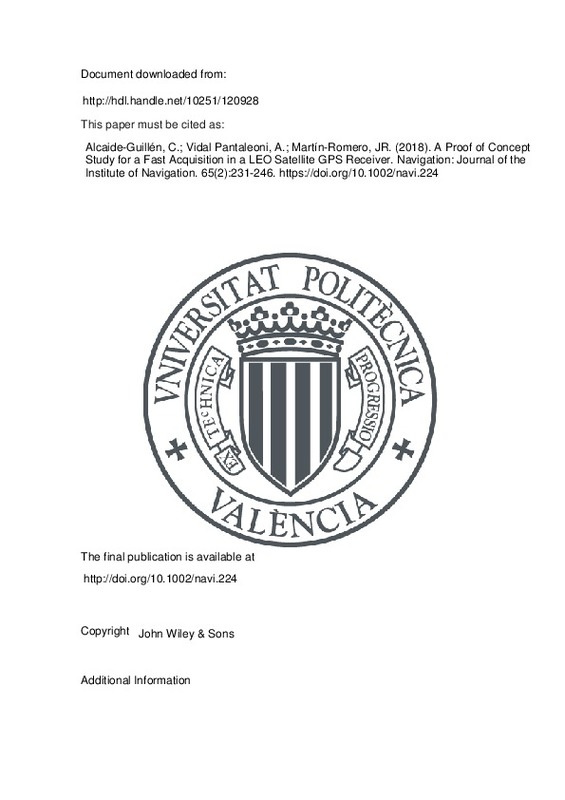JavaScript is disabled for your browser. Some features of this site may not work without it.
Buscar en RiuNet
Listar
Mi cuenta
Estadísticas
Ayuda RiuNet
Admin. UPV
A Proof of Concept Study for a Fast Acquisition in a LEO Satellite GPS Receiver
Mostrar el registro sencillo del ítem
Ficheros en el ítem
| dc.contributor.author | Alcaide-Guillén, Carlos
|
es_ES |
| dc.contributor.author | Vidal Pantaleoni, Ana
|
es_ES |
| dc.contributor.author | Martín-Romero, José Ramón
|
es_ES |
| dc.date.accessioned | 2019-05-22T20:28:37Z | |
| dc.date.available | 2019-05-22T20:28:37Z | |
| dc.date.issued | 2018 | es_ES |
| dc.identifier.issn | 0028-1522 | es_ES |
| dc.identifier.uri | http://hdl.handle.net/10251/120928 | |
| dc.description | This is the peer reviewed version of the following article: Alcaide-Guillén, Carlos, Vidal Pantaleoni, Ana, Martín-Romero, José Ramón. (2018). A Proof of Concept Study for a Fast Acquisition in a LEO Satellite GPS Receiver.Navigation: Journal of the Institute of Navigation, 65, 2, 231-246. DOI: 10.1002/navi.224 , which has been published in final form at http://doi.org/10.1002/navi.224. This article may be used for non-commercial purposes in accordance with Wiley Terms and Conditions for Self-Archiving. | |
| dc.description.abstract | [EN] The aim of this work is to perform a proof of concept study in order to assess if the pre-correlation differential detector can be used to tackle the GPS signal acquisition in a high dynamics scenario problem. The high dynamics scenario to be studied is the case in which a GPS receiver is used in a LEO (Low Earth Orbit) satellite mission. The receiver's appropriateness for the case study is demonstrated via computational cost study and detector statistical characterization. GPS L1 C/A legacy signals for the context are simulated using a Spirent GSS7700 signal generator. The signals are sampled using a USRPX310 as an RF front-end. Using these samples, the receivers are implemented in Matlab using an SDR (Software Defined Radio) experimental setup. A specially designed figure of merit is used to measure the performance of the pre-correlation differential receiver in the realistic LEO satellite case study. Copyright (C) 2018 Institute of Navigation | es_ES |
| dc.language | Inglés | es_ES |
| dc.publisher | John Wiley & Sons | es_ES |
| dc.relation.ispartof | Navigation: Journal of the Institute of Navigation | es_ES |
| dc.rights | Reserva de todos los derechos | es_ES |
| dc.subject.classification | TEORIA DE LA SEÑAL Y COMUNICACIONES | es_ES |
| dc.title | A Proof of Concept Study for a Fast Acquisition in a LEO Satellite GPS Receiver | es_ES |
| dc.type | Artículo | es_ES |
| dc.identifier.doi | 10.1002/navi.224 | es_ES |
| dc.rights.accessRights | Abierto | es_ES |
| dc.date.embargoEndDate | 2019-06-01 | es_ES |
| dc.contributor.affiliation | Universitat Politècnica de València. Instituto Universitario de Telecomunicación y Aplicaciones Multimedia - Institut Universitari de Telecomunicacions i Aplicacions Multimèdia | es_ES |
| dc.contributor.affiliation | Universitat Politècnica de València. Departamento de Comunicaciones - Departament de Comunicacions | es_ES |
| dc.description.bibliographicCitation | Alcaide-Guillén, C.; Vidal Pantaleoni, A.; Martín-Romero, JR. (2018). A Proof of Concept Study for a Fast Acquisition in a LEO Satellite GPS Receiver. Navigation: Journal of the Institute of Navigation. 65(2):231-246. https://doi.org/10.1002/navi.224 | es_ES |
| dc.description.accrualMethod | S | es_ES |
| dc.relation.publisherversion | http://doi.org/10.1002/navi.224 | es_ES |
| dc.description.upvformatpinicio | 231 | es_ES |
| dc.description.upvformatpfin | 246 | es_ES |
| dc.type.version | info:eu-repo/semantics/publishedVersion | es_ES |
| dc.description.volume | 65 | es_ES |
| dc.description.issue | 2 | es_ES |
| dc.relation.pasarela | S\355931 | es_ES |







![[Cerrado]](/themes/UPV/images/candado.png)

